This was published 3 years ago
Thrown in a loop: How Daniel Andrews’ biggest project was cooked up behind closed doors
Originally codenamed Operation Halo, this was an infrastructure project so secret that board members of the government agency responsible for its delivery knew nothing about it until it was announced.
By Timna Jacks, Chip Le Grand and Paul Sakkal
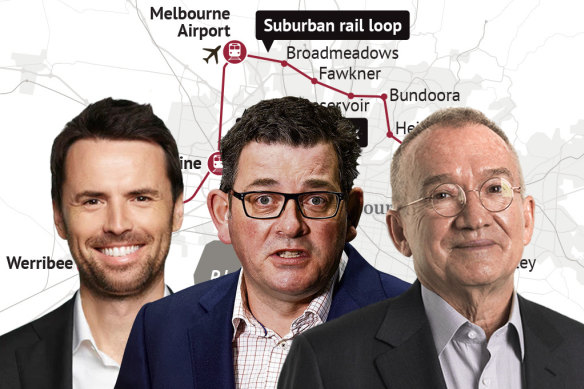
Tom Considine, Daniel Andrews, James MacKenzie - the men at the centre of the state’s Suburban Rail Loop.Credit:
At one minute past 7am on August 28, 2018, as people were boarding trains for their morning commute, Victorian Premier Daniel Andrews’ Facebook page lit up with plans for an ambitious new rail project.
The slick two-minute government advertisement opened with a Lego-like animation showing passengers moving around a brand new underground station. “The biggest public transport project in history is coming to Victoria,” a woman’s voiceover claimed.
As the music (composed by Mark Petrie, a New Zealander who specialises in trailers for Hollywood blockbusters) swelled, the narrator informed Victorians it would carry 400,000 passengers a day, create 20,000 construction jobs and link to more than a dozen suburban stops.
Originally codenamed Operation Halo, this was an infrastructure project so secret that board members of the government agency responsible for its delivery knew nothing about it until it was announced and the senior transport bureaucrat working on its design was legally gagged from telling his boss. All but a handful of government ministers were also kept in the dark.
By the time the Facebook video was posted the project had its final name: the Suburban Rail Loop. A 90-kilometre orbital rail line, this mammoth project was estimated to cost $50 billion but is expected by insiders to finally land at twice that amount. It is the largest and most expensive transport project conceived by a state government.
But as Victoria prepares itself for another election next year, troubling questions hang over this project. Politicians, planning experts and experienced advisers say that by designing and committing to it behind closed doors the government failed to make the transport, planning and financial cases for it.
For a can-do Premier and a government eager to promote its “Big Build” infrastructure program heading into the 2018 election, the promotional video was on-brand. And politically, it worked. The project is considered by analysts to have been the most popular single policy leading into an election that Labor won in a landslide.
But within Development Victoria, the government’s development arm, the Facebook video hit a jarring note. The public agency was charged with overseeing the project, but the board was left out of its planning and only a few trusted insiders were aware it was coming. Among the inner circle were Labor’s go-to board director James MacKenzie, former Labor political adviser Tom Considine and a personal friend of Daniel Andrews, then PricewaterhouseCoopers chief, Luke Sayers.
Transport experts question whether the loop is the best way to spend transport dollars. Its timelines, budgets and ambitions are even now not clearly spelled out. Why did the government prefer to entrust the city’s transport planning to a small coterie of consultants when it has an entire bureaucracy dedicated to that task?
It was, according to RMIT’s centre for urban research director Jago Dodson, “a bald political decision to spend at least $50 billion on the basis of effectively no planning whatsoever”.
Three mates and a bottle in an Airbus
The Age has traced the likely genesis of the Suburban Rail Loop to a conversation between three men held at 30,000 feet in the business-class galley of a Cathay Pacific flight to Hong Kong in 2015. At the bar that day were MacKenzie, businessman Sir Rod Eddington and retired public servant Terry Moran.
Eddington, the chairman of Infrastructure Partnerships Australia and inaugural chairman of Infrastructure Australia, was hand-picked by Victorian premier Steve Bracks a decade earlier to find a way to move people and freight between Melbourne’s eastern suburbs and its fast-growing west. His 2008 report recommended construction of the Metro Tunnel, the Regional Rail Link – an extension of V/Line railway tracks through Melbourne’s outer west – and the East West Link. Eddington’s report set the state’s infrastructure and transport agenda for a generation.
Moran, Bracks’ public service chief and the Department of Prime Minister and Cabinet secretary under Kevin Rudd and Julia Gillard, is one of the nation’s most respected bureaucrats. Like Eddington, he’d known MacKenzie for many years.
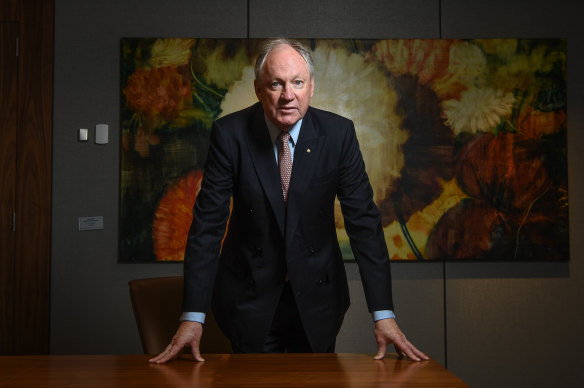
Rod Eddington.Credit: Justin McManus
What began as three friends sharing a fine bottle of wine at the pointy end of an Airbus A330 became a wide-ranging discussion about the future shape of Melbourne, then nearing a population of 5 million, and how to ease the city’s growing pains. An orbital rail loop was not discussed, but Eddington’s and Moran’s independent recollections suggest that, between them, they planted the seed in MacKenzie’s mind. MacKenzie has since confirmed this to people involved in the project.
Eddington believed then, as he does now, that to remain liveable, Melbourne needed an urban rail network comparable to the London Underground, Paris Metro or Hong Kong’s MTR. In the midair conversation, he reflected that the Metro Tunnel, first proposed in his 2008 report, was intended as the first of multiple lines in an underground rail system to be built over 30 or 40 years.
Moran argued that the flaw in Eddington’s contentious East West Link — a road tunnel supported by the Napthine government but rejected by Labor — was that it directed more traffic in and out of the city centre. The key to Melbourne’s future liveability was developing suburban hubs, reducing pressure at the centre. As their plane travelled north above the Pacific, he explained that the cost of building those hubs could be met partly by capturing the value of developing the land around them.
This was not a new idea. Successive government plans for the city have argued that if Melbourne is to cope with a doubling of its population to a forecast eight million by 2051, jobs and key business centres need to be spread around the city. The city’s latest planning blueprint, Plan Melbourne, identified Werribee, Sunshine, Bundoora, Heidelberg, Clayton, Parkville, Dandenong and Fishermans Bend as precincts to be prioritised for jobs, housing, urban renewal and integrated transport links.
As the coronavirus pandemic prompts a shift away from the once-bustling CBD, planners say these objectives have become even more pressing.
MacKenzie, who declined to be interviewed for this story, disembarked from that Cathay Pacific flight with two clear takeouts: the need for more underground rail and better suburban hub development. Multiple sources involved in Operation Halo say the idea for the Suburban Rail Loop was to solve both those problems.
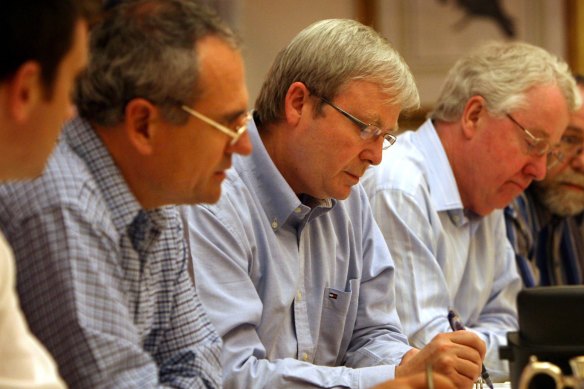
Then Treasury Secretary Ken Henry, Prime Minister Kevin Rudd and Prime Minister Cabinet Secretary Terry Moran in 2008.Credit: Glen McCurtayne
Its construction would stimulate development of many of the suburban hubs identified by Plan Melbourne, with new stations proposed for Monash, Deakin and La Trobe universities and a single, continuous underground loop running through Sunshine and Werribee.
At least that was how it started off.
A small team on a big job
In the eyes of Victorian Labor, James MacKenzie is a proven quantity and a safe pair of hands. A former chair of the Transport Accident Commission and president of the Victorian Arts Centre Trust, he was the businessman chosen by Labor to publicly assess its 2014 campaign costings.
MacKenzie is not as personally close to Daniel Andrews as he was to Bracks but when it came to seeking government support for the Suburban Rail Loop he didn’t need to be. One of his senior executives at the newly-formed Development Victoria, Tom Considine, was a former top adviser to Andrews.
When Andrews was leading Labor in opposition, Considine coordinated the party’s policies for the 2014 election. After that poll he worked as a chief of staff to Treasurer Tim Pallas. Government sources say that in that role Considine remained the eyes and ears of the Premier.
A shrewd political operative, Considine is genuinely interested in big ideas. At Development Victoria, with the firm backing of MacKenzie, he was given full rein to indulge both passions and a broad remit to explore the feasibility of a city-changing project like the Suburban Rail Loop. He flew to London and New York with MacKenzie on a taxpayer-funded trip to investigate the railways in these mega-cities, two months before the 2018 poll. Operation Halo was Considine’s baby.
“Is it a precinct project or a transport project? If it’s a transport project there are a hell of a lot of better ways to spend your money.”
A consultant working on the Suburban Rail Loop
When the project was conceived in early 2017, a small team at PwC was commissioned to do a month’s work on what the construction of a new orbital rail line could mean for real estate values and economic activity. A route was devised and thought given to the role of capturing the value from the development. To Considine and MacKenzie this was much more than transport; it was about transforming Melbourne into a polycentric city.
In mid-2017, MacKenzie called a meeting with PwC partners and PwC chief executive Luke Sayers to request a preliminary business case. It was little more than a tyre-kicking exercise — the government had then estimated a full business case would take three years and at least $15 million to develop.
At the meeting in the PwC building MacKenzie emphasised the need for absolute secrecy. It was understood that if anyone leaked their plans, they could be sacked.
On the 20th floor of the Skyscraper Centre, PwC’s glass-and-steel headquarters in Southbank overlooking the Yarra, 25 to 30 consultants from PwC and Aurecon worked on Operation Halo’s design and economic feasibility. Each was required to sign a non-disclosure agreement barring them from discussing their work with anyone outside the project team, including their bosses. They worked in designated offices on the partners’ floor, separate from the main open-floor office area for six months, on a part-time basis. No documents were to leave the locked rooms.
Corey Hannett, director-general of the Major Transport Infrastructure Authority, was brought in to provide additional engineering and design advice, but he too was required to sign a non-disclosure agreement. This had the effect of concealing the project from the person he was supposed to report to: departmental secretary Richard Bolt.
Bolt, who declined to be interviewed for this story, and the state’s head of transport, Gillian Miles, both left the newly-named department shortly after the Suburban Rail Loop helped re-elect the Andrews government.
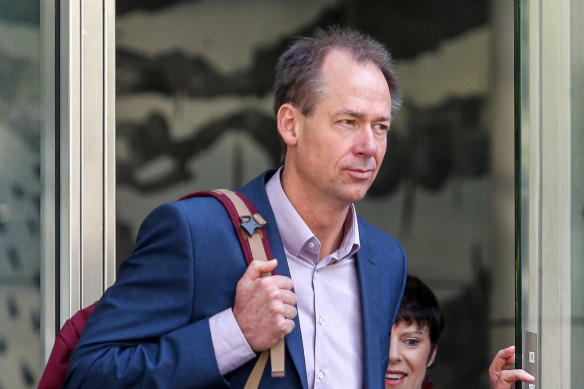
Richard Bolt in 2016.Credit: Eddie Jim
In an interview with The Age, Transport Infrastructure Minister Jacinta Allan said measures taken to keep the rail loop project secret were in line with normal Cabinet procedures. Any leaks would have raised the risk of land speculation.
“This project was developed in the usual way that respected Cabinet confidentiality," Allan said.
Politics first
Normally, the sprawling super-department of Economic Development, Jobs, Transport and Resources, then run by Bolt, is where a government would turn for apolitical, expert advice on rail construction and urban development and a cost-benefit analysis of what a project like the Suburban Rail Loop might bring.
But documents obtained by the Opposition under freedom of information show the first mention of the project in Development Victoria board correspondence was the morning of the announcement, when a phone hookup was hastily organised under the title “Suburban Rail Loop Collateral”.
Development Victoria directors who dialled into the meeting describe a mixture of bemusement and angst as MacKenzie explained why they had been kept in the dark. One board member said it was clear from the discussion that support for the rail loop had come from “on high”. Everyone understood that MacKenzie, the chair of union-friendly law firm Slater and Gordon and the Victorian Fund Management Corporation responsible for $69.4 billion in public sector assets, had a direct line to the Premier.
Even inside the Andrews government, information about what was being cooked up in the PwC tower was known to only a handful of ministers. Tim Pallas and Gavin Jennings, Daniel Andrews’ Special Minister for State who managed the government’s relationship with senior public servants, were the first to be told. Then the Premier, then Major Projects Minister Jacinta Allan and finally, Deputy Premier James Merlino were briefed.
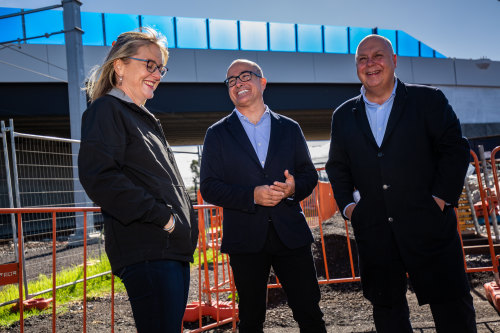
Minister for Transport Infrastructure Jacinta Allan, Deputy Premier James Merlino and Treasurer Tim Pallas.Credit: Scott McNaughton
Not by coincidence, this gang of five also formed Labor’s Policy Group responsible for developing the policy basis of its campaign for re-election the following year.
From the moment the Suburban Rail Loop was embraced by this group, it was treated as an election promise first and government policy second. This is the justification cited by senior government sources for using consultants and Development Victoria, rather than Bolt’s department, to plan it.
But keeping a $50 billion project a secret required extraordinary steps. Annual reports reveal that government money to pay for consultancy work was funnelled from the Department of Premier and Cabinet to Development Victoria, with the contracts personally signed by then Department of Premier and Cabinet secretary Chris Eccles. Evidence of these payments appear in the Development Victoria annual reports as a $1.36 million payment from DPC in 2017-2018 for a “civic infrastructure project” and a further $2 million for “project cost recovery” the following year.
Eccles put bureaucratic responsibility for the project in the hands of Simon Phemister, a fast-rising deputy secretary within DPC. After Bolt left in 2018, Phemister — a protege of Eccles who developed a close relationship with the Premier’s key staffers — was given his job. Hannett, the head of the agency overseeing the Metro Tunnel and West Gate Tunnel projects, was the government’s leading expert on tunnels and the most senior transport bureaucrat brought into the project. Hannett reported directly to Allan.
But within the gang of five ministers, a turf war was brewing.
Transport v urban development
Multiple sources close to the government said Jennings, as the Minister for Priority Precincts, was sold on the conception of Operation Halo as an urban development project that would stimulate the growth of suburban hubs and believed the project came under his portfolio.
But Jacinta Allan, then-minister responsible for major projects and public transport, saw the SRL as essentially a transport project firmly within her realm, according to the sources.
Jennings abruptly quit the government in March 2020. He has never spoken about what made him quit, and he declined to be interviewed for this story. Allan was immediately handed Jennings’ precincts portfolio and two months later was given the newly created role of Suburban Rail Loop Minister. Allan would not be drawn on the alleged rift between the ministers in questions from The Age.
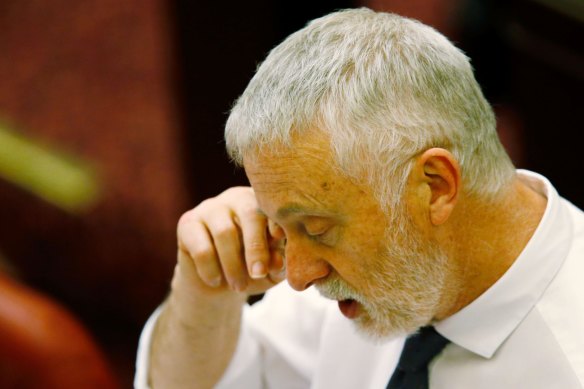
Gavin Jennings.Credit: Darrian Traynor
The two competing conceptions of the rail loop played out in multiple name changes for the project. In 2017, Halo first became the Urban Development Program, reflecting its more ambitious, city-building goals. This was subsequently changed to simply Orbital Rail. In early 2018 the government settled on Suburban Rail Loop. The debates were also played out in questions over where it would run, where it would stop and when it would be built.
Initial plans drawn up by consultants were for a continuous loop and possibly, several — a highly interconnected rail network modelled on those in other world capitals, with multiple cross-city options at stations that also served as centres for shops and high density apartments.
The route needed to be carefully chosen and the implications for local planning and development considered. This would require time, patience and, once the project went live, extensive community and stakeholder consultation. Construction could not reasonably start until 2026.
In August 2018, Premier Andrews made the call. It would be a single rail line, its alignment set, and its construction to begin in 2022.
A consultant who worked on Operation Halo questioned what Victoria had been left with: “Is it a precinct project or a transport project? Because, if it is a transport project, there are a hell of a lot of better ways to spend your money.”
Meanwhile, most of those who advocated for the Loop in secret have consolidated their influence. MacKenzie was handpicked to chair the authority established to build the project. In 2020, he brought Considine in as interim chief executive of the authority, which has since hired seven former Andrews government ministerial advisers or DPC staffers.
Considine has since left the Suburban Rail Loop Authority to become a partner at Sayers’ consulting firm. Industry sources say the firm is bidding for work on the project, but when contacted by The Age, Sayers said he was unable to comment on client-related matters and the government said the firm was not a prospective contractor.
In June this year, Considine was appointed to the board of Victorian Funds Management Corporation, chaired by MacKenzie. That same month, MacKenzie was appointed as co-chair of a separate board overseeing the redevelopment of the Melbourne arts precinct.
Growing scepticism
If the Suburban Rail Loop delivers what it was originally designed to do — and what the launch-day brochure claimed — it will be a transformative project that makes it easier for people to live, work and commute in the city.
Changing the city’s 19th century spoke-and-wheel rail system by building an orbital link would reduce cross-city train commutes, as people would no longer need to travel into the city to get around it. It would be a circuit breaker for decades of car-oriented transport planning in Melbourne, freeing up congested freeways with desperately needed railway stations finally built in Doncaster, Burwood and the Monash University Clayton campus, where buses are bursting at the seams.
Allan says the loop delivers the calls of Plan Melbourne to respond to forecast population growth by boosting density in the suburbs and creating better public transport links that ease the pressure on constrained roads.
“The radial rail network was not going to deliver the public transport network that was needed for a city that was going to be the size of London by the late 2050s. We needed a game changer,” Allan said.
“Plan Melbourne’s aspiration is to have a city of centres and that’s what the Suburban Rail Loop realises.”
This vision captured the hearts and minds of voters in 2018, with an average primary vote swing of 6.3 per cent to the ALP in the 11 electorates where stations were promised, compared with a 4.75 per cent statewide average. Of the eight seats Labor picked up at the 2018 election, three — Box Hill, Burwood and Mount Waverley — were electorates where new stations were planned.
While the policy’s political success is difficult to quantify with precision, strategists from both sides say the pitch had broad appeal to voters wanting better transport, and fitted with Andrews’ image as a can-do premier.
But if the rail loop is as compromised as Labor insiders and transport and some planning experts fear, it could end up as an underused rail line that starts at Southland and ends abruptly at Box Hill. If this happens, it may well share the fate of its ill-conceived predecessor, the Outer Rail Circle, built for Marvellous Melbourne in the 1890s. That train line failed to attract customers and shut three years after opening. Its remnants can still be found in the wilds of Kew.
Now, three years after it committed to the project, the government is preparing to release an 800-page investment case, which will reveal the cost of building the first stage — a 26-kilometre tunnel through the south-east and eastern suburbs — and detailed transport and financial modelling.
Some transport experts argue that, for a fraction of the cost, orbital buses or light rail could be prioritised over underground rail, making it possible to build multiple loops rather than just one. They question how an underground rail line through the suburbs could be deemed financially viable, given the city’s low densities and relatively low public transport use.
RMIT’s Jago Dodson says city-shaping transport plans require years of analysis, discussion and consultation of the kind the Suburban Rail Loop did not get.
“It’s very difficult to think of a comparable example of a project of this scale that has been announced with virtually no public discussion, no analysis, no preliminary deliberations or planning documentation,” Dodson said. “What level of demand will there be for the Suburban Rail Loop? That’s a pretty fundamental question.”
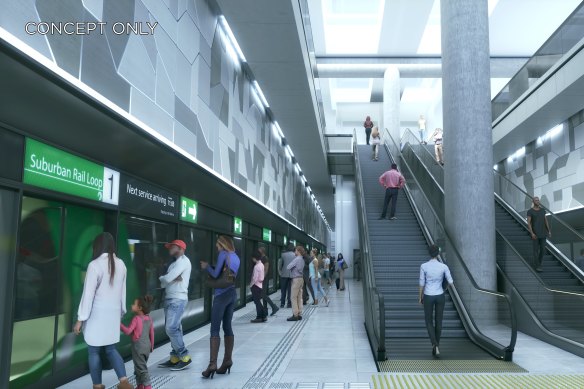
An artist's impression depicting stage one of the Victorian government's proposed Suburban Rail Loop.
In bypassing the state’s transport department or Infrastructure Victoria — an independent advisory set up by Premier Andrews to depoliticise infrastructure building — the government cut out of the loop those who could help answer these questions, and abandoned the usual bureaucratic checks and balances.
It’s the sort of criticism levelled recently at the Morrison government’s controversial commuter car parking program.
The Grattan Institute’s cities and transport director Marion Terrill says these two projects reflect a growing tendency to rush out mega-projects at election time, leading to rash decisions and cost blowouts. One third of the country’s mega projects that were announced without proper planning account for three-quarters of all project cost overruns, Terrill’s research shows. “Whose job is it to say actually there’s a better way to do this, or a cheaper way?” Terrill asks of the rail loop. “It’s got to be someone’s job.”
But Terry Moran says splashing cash on projects before an election is the reality of modern politics.
“The only way to get things done is to get the government to commit themselves to spending the money and the only way to do that often is taking something into an election,” Moran said. ”If the government is re-elected, it can say it has legitimate political support to proceed.”
But there are costs. The Suburban Rail Loop risks overshadowing projects outlined in 30-year transport plans, including the construction of an underground rail line connecting Newport with Clifton Hill via Fishermans Bend, the long-awaited Rowville rail line, and electrification of tracks to the fast-growing western suburbs.
A government insider with knowledge of the project said that even before it was announced, the Andrews government’s infrastructure project pipeline was too large and ambitious for the construction industry’s capacity to deliver.
“We were over-cooking the books as it was. There is no way we should have been trying to get away all these projects simultaneously. There were too many of them and the construction industry was ripping us off unmercifully.”
There is growing scepticism, within government and outside, that the Suburban Rail Loop will ever be built. A project completion date of 2050 means future Victorian premiers will have the task of building the largest section of Andrews’ rail line — possibly more than 60 kilometres — while juggling construction projects of their own.
If the 2018 election promise slips through the cracks, all that will be left is a glossy brochure, a slick video and an epic soundtrack in our ears.